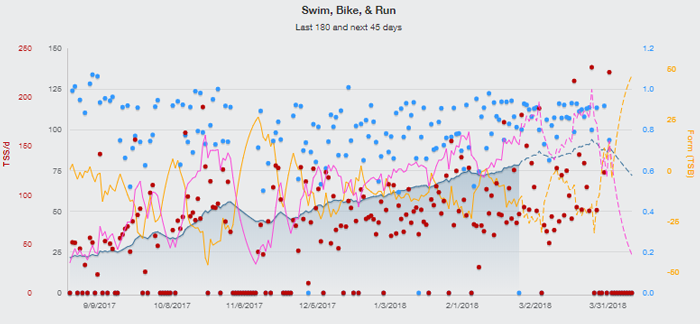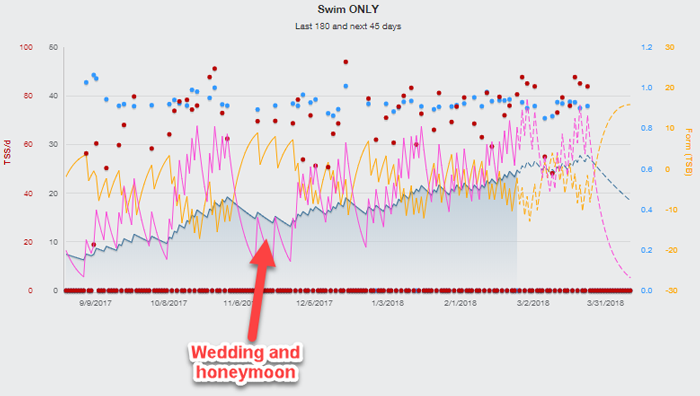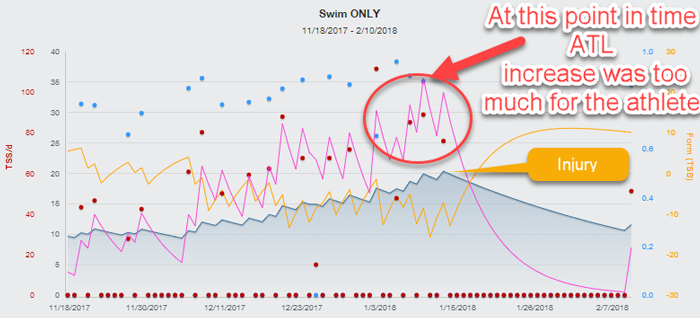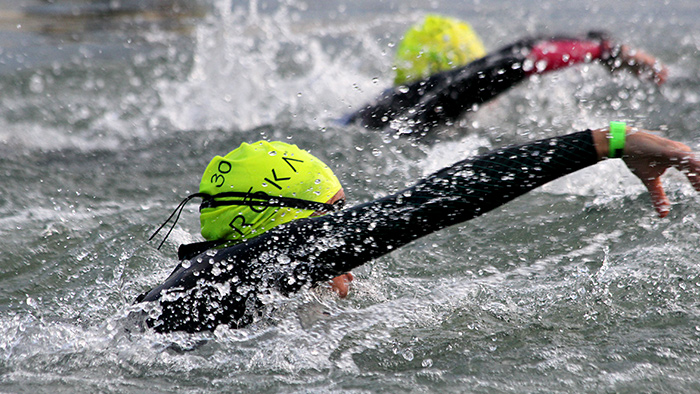As a competitive triathlete or a serious swimmer, you probably have read numerous articles about swim stroke, how to optimize it, how to view it on TrainingPeaks, and how to plan for it. Here are some tips for how to best calculate swim zones in TrainingPeaks to improve your pacing and better plan for your next race.
At the moment there aren’t a lot of specific swimming zones that are accurate for every swimmer. Power meters for cycling and running have allowed us to take a much more scientific approach to training, but the swim has been left behind and hasn’t had much zone-focused training.
To help debunk some of the swim mystery, I will discuss critical factors that affect your swim workouts, assist in setting your proper swim zones, and how to optimize your training while viewing the TrainingPeaks information.
If you have used TrainingPeaks, you will understand just how easy it is to gain fitness/fatigue in the swim. Your Training Stress Score® (TSS®) numbers will be very high when viewing or planning workouts. You will take a bigger hit on a swim workout than any other on the TrainingPeaks platform.
Your numbers can (and will) balloon out of control if you let them. So when should you pull back on the swim and allow for recovery, just as you would on the bike or run? Let’s take a look at the Performance Management Chart (PMC), which you see below. It usually looks something like this:

To maintain a proper Training Stress Balance (TSB), the yellow line on the chart above, and Fatigue level (the pink line on the chart above) during your training in other sports, heart rate (HR) zones, power zones, and pace zones are extremely important.
If you try to convert some of the more popular zones to the swim, it gets quite confusing. To illustrate the point a little clearer, let’s look at it from a different angle. Let’s say I have a HR threshold on the run of 180 bpm. If I want to run at 85 percent of that I will be at a 153 HR. Now let’s say I have a swim threshold of 1:23 min/100yd (average pace over the course of a 1,000yd test). If I want to swim at 85 percent of that T-pace, it will be 1:38 min/100yd.
Swimming at a speed this slow compared to your threshold changes how you swim. Your stroke rate will most likely drop and lengthen. This in turn will cause you to over-glide in your stroke causing a chain reaction of negative effects.
The first step in identifying your zones is to perform a 1,000 TT-effort test after a warm-up. From the result of this test, you will calculate your average pace per 100 (yards or meters). This average 100 time will become your threshold pace or “T-Pace.”
If you are an experienced swimmer (college/Masters/consistent swimming) you can take this average directly. If you are new to the sport or have not been consistently swimming, it is usually a good idea to add on another second to your average 100 time. After a couple of weeks/training cycles, if you are responding appropriately you can bump your threshold to the average 100 pace.
To determine if a swimmer is ready to bump up their threshold, I have athletes take the same 1,000 yd/m test again (a couple weeks later) and watch for the following:
A). Have they improved their ability to hold their pace over the course of the test compared to last time?
B). Is their pace steady and consistent?
If I can answer “yes” to these questions, then their new average pace should equal their threshold pace.
Before I present my swim zones, I should mention they work the same regardless of your T-pace. Whether your threshold is 1:23 or 2:10 per 100 yd/m. The zones that I have seen an improvement in all athlete types are below:
| Coquelin Swim Zones | |
| Warm up Zone | 89-90% |
| Grey Zone | 91% |
| Endurance Zone | 92-94% |
| Tempo Zone | 95-98% |
| Threshold Zone | 99-106% |
| Supra threshold | 106-119% |
| All Out Effort | 120% and over |
Because the swims are at an Intensity Factor (IF) much higher than what is expected on TrainingPeaks this will result in two things:
- You will be getting higher TSS (Training Stress Score) numbers compared to other workouts because the IF (intensity factor) is viewed as very high.
- This will give you a bigger number to ATL (fatigue) and affect your TSB (form) more.
This causes the PMC numbers you are tracking to look a little different than expected. When using this method during periods when overall volume/intensity is higher, you will have slightly lower TSB numbers (in negatives) and slightly higher ATL numbers (positives).
This may be alarming initially, but you have to remember with the zones listed above being higher than normal comes a different way to read the PMC on TrainingPeaks. For other sports such as cycling or running you don’t want to stay below -20 TSB for very long because it leads to injuries/overtraining.
The same holds true for swimming but you can move that worry zone just a touch further to account for the numbers you will be seeing from these swim zones listed earlier.
Another helpful tip is to have multiple PMC charts on your dashboard. This will allow you to see what your true fitness is in each sport and further break down your ramp rate in each discipline.
Which leads me to my next point: How much (swim) fitness should you gain over the course of a seven day period?
Appropriate ramp rate of 3 to 6 CTL points per week will allow you to not go below the -20 TSB level in the swim specific PMC. Take a look at an appropriate swim progression:

Once you start to strive for more than 6 CTL points in a one-week period, it usually doesn’t end well unless that person is a seasoned swimmer who hasn’t been logging their workouts until now. Some athletes will start to react negatively once you dip below -17TSB, as is the case here:

Most won’t have a problem going a bit lower than that. Keep in mind the experience of you or your athlete before spending extended periods of time below this point. Doing so with athletes who are not accustomed to this type of swim training will almost always result in injuries.
So just a quick recap of everything we talked about:
- You’ll benefit from using swim zones.
- Ramp rates of more than 6 CTL points in one week are higher risk for injury.
- When TSB dips below -17 you are asking for trouble.

